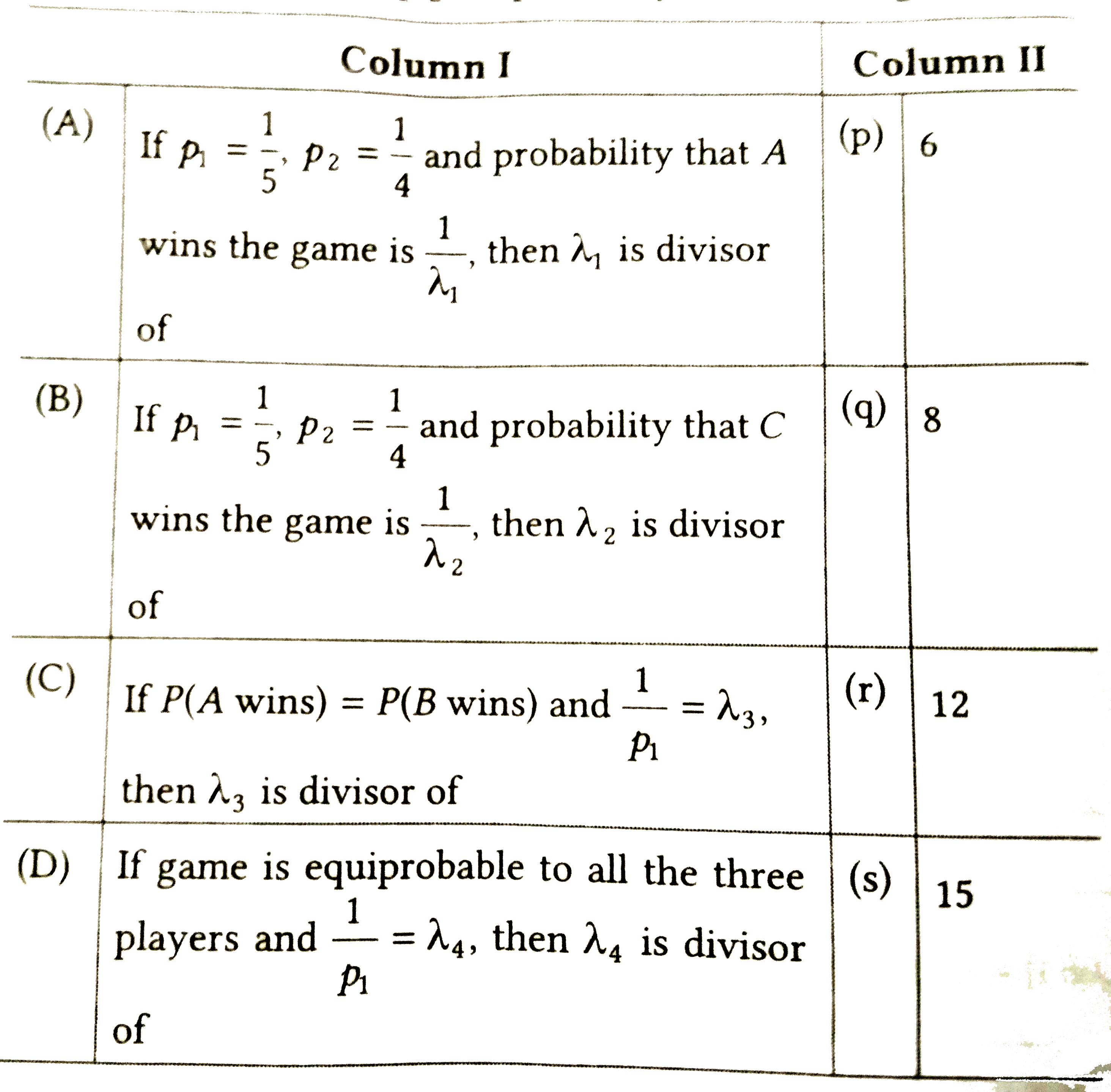A and B take turns in throwing two dice, the first to throw 9 being awarded the prize. Show that their chance of winning are in the ratio 9:8.
To solve the problem of A and B taking turns throwing two dice until one of them rolls a sum of 9, we will follow these steps:
Step 1: Calculate the Probability of Rolling a Sum of 9
When rolling two dice, the possible outcomes that result in a sum of 9 are:
- (3, 6)
- (4, 5)
- (5, 4)
- (6, 3)
Thus, there are 4 favorable outcomes for rolling a sum of 9.
The total number of outcomes when rolling two dice is 6×6=36.
So, the probability P(E) of rolling a sum of 9 is:
P(E)=Number of favorable outcomesTotal outcomes=436=19
Step 2: Calculate the Probability of Not Rolling a Sum of 9
The probability of not rolling a sum of 9, denoted as P(¯E), is:
P(¯E)=1−P(E)=1−19=89
Step 3: Determine the Winning Probability for Player A
Player A can win on their first turn, third turn, fifth turn, etc. The probability of A winning on their first turn is simply P(E)=19.
For A to win on the third turn, B must fail to roll a 9 on their first turn, and A must roll a 9 on their second turn:
P(A wins on 3rd turn)=P(¯E)⋅P(¯E)⋅P(E)=(89)⋅(89)⋅(19)=64729
For A to win on the fifth turn, both A and B must fail to roll a 9 in the first four turns, and A must roll a 9 on the fifth turn:
P(A wins on 5th turn)=P(¯E)4⋅P(E)=(89)4⋅(19)=40966561
Step 4: Generalize the Winning Probability for Player A
The total probability of A winning can be expressed as an infinite series:
P(A wins)=P(E)+P(¯E)2⋅P(E)+P(¯E)4⋅P(E)+…
This can be factored as:
P(A wins)=P(E)(1+P(¯E)2+P(¯E)4+…)
Step 5: Recognize the Series as a Geometric Series
The series inside the parentheses is a geometric series with the first term 1 and common ratio P(¯E)2=(89)2=6481:
Sum=11−6481=11781=8117
Thus, we have:
P(A wins)=19⋅8117=917
Step 6: Calculate the Winning Probability for Player B
Since the total probability must equal 1, the probability of B winning is:
P(B wins)=1−P(A wins)=1−917=817
Step 7: Find the Ratio of Winning Chances
The ratio of the chances of A winning to B winning is:
Ratio=P(A wins)P(B wins)=917817=98
Thus, the chances of A and B winning are in the ratio 9:8.
When rolling two dice, the possible outcomes that result in a sum of 9 are:
- (3, 6)
- (4, 5)
- (5, 4)
- (6, 3)
P(E)=Number of favorable outcomesTotal outcomes=436=19
The probability of not rolling a sum of 9, denoted as P(¯E), is:
P(¯E)=1−P(E)=1−19=89
Player A can win on their first turn, third turn, fifth turn, etc. The probability of A winning on their first turn is simply P(E)=19.
P(A wins on 3rd turn)=P(¯E)⋅P(¯E)⋅P(E)=(89)⋅(89)⋅(19)=64729
P(A wins on 5th turn)=P(¯E)4⋅P(E)=(89)4⋅(19)=40966561
The total probability of A winning can be expressed as an infinite series:
P(A wins)=P(E)+P(¯E)2⋅P(E)+P(¯E)4⋅P(E)+…
This can be factored as:
P(A wins)=P(E)(1+P(¯E)2+P(¯E)4+…)
The series inside the parentheses is a geometric series with the first term 1 and common ratio P(¯E)2=(89)2=6481:
Sum=11−6481=11781=8117
P(A wins)=19⋅8117=917
Since the total probability must equal 1, the probability of B winning is:
P(B wins)=1−P(A wins)=1−917=817
The ratio of the chances of A winning to B winning is:
Ratio=P(A wins)P(B wins)=917817=98
Topper's Solved these Questions
Similar Questions
A and B take turns in throwing two dice, the first to throw 10 being awarded the prove, show that if A has the first throw, their chance of winning are in the ratio 12:11.
View SolutionTwo persons A and B take turns in throwing a pair of dice. The first person to throw 9 from both dice will be awarded the prize. If A throws first, then the probability that B wins the game is 9/17 b. 8/17 c. 8/9 d. 1/9
View SolutionA and B throw a pair of die turn by turn. The first to throw 9 is awarded a prize. If A starts the game, show that the probability of A getting the prize is 917
View SolutionThree players A, B and C alternatively throw a die in that order, the first player to throw a 6 being deemed the winner. A's die is fair whereas B and C throw dice with probabilities p1andp2 respectively, of throwing a 6.

View SolutionA, B and C in order throw an unbiased coin. The first who throws head wins. Find the respective probabilities of winning
View SolutionA, B, and C in order toss a coin. The one to throw a head wins. What are their respective chances of winning assuming that the game may continue indefinitely?
View SolutionA and B throw a pair of dice. If A throws 9, find B’s chance of throwing a higher number.
View SolutionIn a single throws of two dice, what is the probability of getting a total of at most 9?
View SolutionFind the chance of throwing a total of 3 or 11 with two dice.
View SolutionA and B throw a pair of dice. If A throws 9, find B's chance of throwing a higher number.
View Solution
